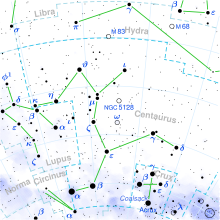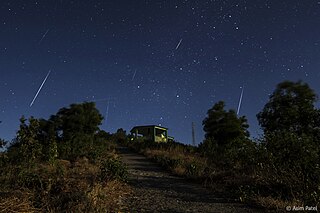
The Geminids are a prolific meteor shower caused by the object 3200 Phaethon, which is thought to be a Palladian asteroid with a "rock comet" orbit. This would make the Geminids, together with the Quadrantids, the only major meteor showers not originating from a comet. The meteors from this shower are slow moving, can be seen in December and usually peak around December 4–16, with the date of highest intensity being the morning of December 14. The shower is thought to be intensifying every year, and recent showers have seen 120–160 meteors per hour under optimal conditions, generally around 02:00 to 03:00 local time. Geminids were first observed in 1862, much more recently than other showers such as the Perseids and Leonids.

A meteor shower is a celestial event in which a number of meteors are observed to radiate, or originate, from one point in the night sky. These meteors are caused by streams of cosmic debris called meteoroids entering Earth's atmosphere at extremely high speeds on parallel trajectories. Most meteors are smaller than a grain of sand, so almost all of them disintegrate and never hit the Earth's surface. Very intense or unusual meteor showers are known as meteor outbursts and meteor storms, which produce at least 1,000 meteors an hour, most notably from the Leonids. The Meteor Data Centre lists over 900 suspected meteor showers of which about 100 are well established. Several organizations point to viewing opportunities on the Internet. NASA maintains a daily map of active meteor showers.

The Perseids are a prolific meteor shower associated with the comet Swift–Tuttle. The meteors are called the Perseids because the point from which they appear to hail lies in the constellation Perseus.
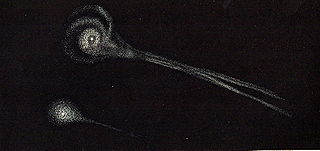
Biela's Comet or Comet Biela was a periodic Jupiter-family comet first recorded in 1772 by Montaigne and Messier and finally identified as periodic in 1826 by Wilhelm von Biela. It was subsequently observed to split in two and has not been seen since 1852. As a result, it is currently considered to have been destroyed, although remnants appeared to have survived for some time as a meteor shower, the Andromedids.

The Ursid (URS) meteor activity begins annually around December 17 and runs for over a week, until the 25th or 26th. This meteor shower is named for its radiant point, which is located near the star Beta Ursae Minoris (Kochab) in the constellation Ursa Minor.

The Eta Aquariids are a meteor shower associated with Halley's Comet.
The Beta Taurids (β–Taurids) are an annual meteor shower belonging to a class of "daytime showers" that peak after sunrise. The Beta Taurids are best observed by radar and radio-echo techniques.

13P/Olbers is a periodic comet with an orbital period of 69 years. It fits the classical definition of a Halley-type comet with.
The October Draconids, in the past also unofficially known as the Giacobinids, are a meteor shower whose parent body is the periodic comet 21P/Giacobini-Zinner. They are named after the constellation Draco, where they seemingly come from. Almost all meteors which fall towards Earth ablate long before reaching its surface. The Draconids are best viewed after sunset in an area with a clear dark sky.
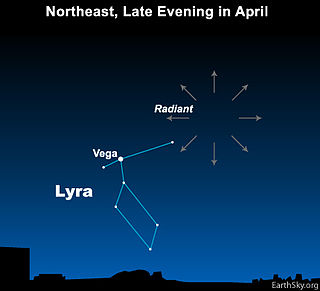
The April Lyrids are a meteor shower lasting from April 16 to April 25 each year. The radiant of the meteor shower is located in the constellation Lyra, near its brightest star, Vega. The peak of the shower is typically around April 22 each year.

The Arietids are a strong meteor shower that lasts from May 22 to July 2 each year, and peaks on June 7. The Arietids, along with the Zeta Perseids, are the most intense daylight meteor showers of the year. The source of the shower is unknown, but scientists suspect that they come from the asteroid 1566 Icarus, although the orbit also corresponds similarly to 96P/Machholz.
The Eta Carinids are a meteor shower lasting from January 14 to 27 each year, peaking on January 21. C. S. Nilsson of the Adelaide Observatory discovered them in 1961 in Australia. Roughly two to three meteors occur per hour at its maximum. It gets its name from the radiant which is close to the stellar system Eta Carinae.

The Andromedids meteor shower is associated with Biela's Comet, the showers occurring as Earth passes through old streams left by the comet's tail. The comet was observed to have broken up by 1846; further drift of the pieces by 1852 suggested the moment of breakup was in either 1842 or early 1843, when the comet was near Jupiter. The breakup led to particularly spectacular showers in subsequent cycles.
The Virginids are a meteor shower. There are many major and minor meteor shower streams that occur during the Virginid Complex, including the Alpha Virginids, Gamma Virginids, Eta Virginids, Theta Virginids, Iota Virginids, Lambda Virginids, Mu Virginids, Pi Virginids, and Psi Virginids, and March Virginids, emanating mostly from the constellation Virgo between February and May. Collectively, the shower normally lasts from late January to mid-April and into early May, peaking in March and April, with one to two meteors per hour on average. The main radiant shifts southeastwards from central Leo in late January to central Virgo near Spica in mid-May.
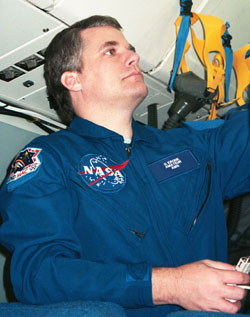
Gary W. Kronk is an American amateur astronomer and writer.

Aurigids is a meteor shower occurring primarily within September.

The Zeta Perseids (ζ–Perseids) are a daylight meteor shower that takes place from about May 20 to July 5. On the peak date of June 13, the radiant is only 16 degrees from the Sun. The shower was discovered at Jodrell Bank Observatory in 1947 using radio equipment. The Zeta Perseids and Beta Taurids are both probably associated with the Taurid Complex of meteor showers. The Arietids and Zeta Perseids maxima tend to blend into one another.

209P/LINEAR is a periodic comet with an orbital period of 5.1 years. The comet has extremely low activity for its size and is probably in the process of evolving into an extinct comet.
The Gamma Normids (GNO) are a weak meteor shower, active from March 7 to 23, peaking on March 15. The radiant is located near the star Gamma2 Normae in the constellation Norma.
